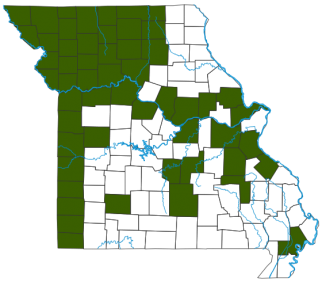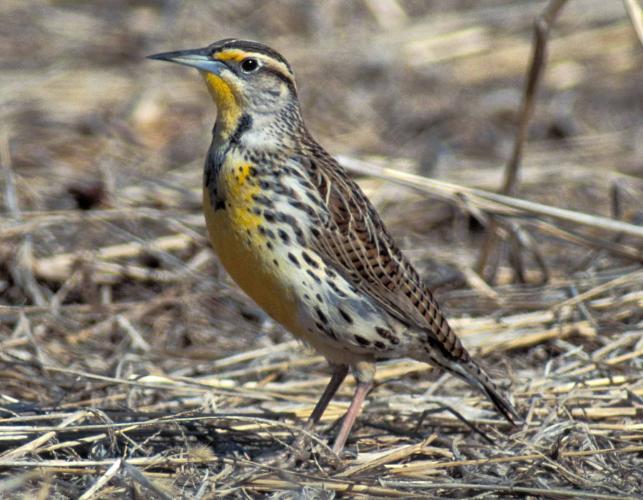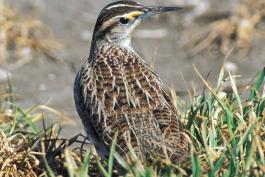
Upperparts of the western meadowlark are medium to light brown with pale feather edges, lacking dark centers as in eastern meadowlarks. The crown is dark, with a light median stripe, white eyebrow, dark eye line, and yellow moustachial streak. The six outer tail feathers are white or partially white. The inner six brown tail feathers have narrow bars without a dark center to the feathers. Underparts are yellow, with a black V on the breast and dark spots on the flanks. The under tail feathers are white. Song is a beautiful, clear, descending whistle followed by a flutelike gurgling that fades near the end. Call is a dull chuck or chup.
Similar species: The eastern meadowlark is a common permanent resident statewide. Upperparts are darker, the feathers having dark centers that western meadowlarks lack. Moustachial streak is white. Dark marks on the flanks look streaked. The song is very different, a pair of clear, descending whistles: tsee-you, tsee-yer. Call is a harsh dzzzzzert.
Length: 9½ inches (tip of bill to tip of tail).

Can occur statewide but is most common in the northwest corner as a permanent resident, and western and southwestern Missouri in winter.
Habitat and Conservation
Lives in open, grassy areas, including pastures, prairies, crop fields, and airports. Like the eastern meadowlark, spends most of the time on the ground, foraging for insects and seeds. During breeding season, males are more conspicuous when they sing territorial messages from prominent places such as fence posts, treetops, and power lines. Where eastern and western meadowlark ranges overlap, western meadowlarks usually live in higher, drier grasslands.
Food
The sharp, long bills of meadowlarks allow them to hunt ground-dwelling insects such as grubs, crickets, and grasshoppers. Like many other members of the blackbird family, they jab their strong, swordlike bills into the soil, then open their jaws, prying open the grass and soil, uncovering grubs and other “goodies.” In winter, they also eat seeds.
Status
Common permanent resident in northwest corner of the state. Rare and scattered in the remainder of the state, with some breeding occurrences in the Osage Plains of west central Missouri. Since the 1960s, western meadowlark populations have been steadily declining throughout their range. Habitat loss and degradation and pesticide use may be causes.
Life Cycle
Meadowlarks are ground nesters. In a small depression on the ground, the female builds a cup-shaped nest of grasses and other plant materials, often also weaving a roof and an arched, tunnel-like entrance several feet long. A clutch usually comprises 5 or 6 eggs, and the young hatch naked and helpless. They can leave the nest 10 to 12 days after hatching. Don’t disturb nesting meadowlarks. Females will abandon their eggs if scared off the nest.
Human Connections
Meadowlarks devour many insects that humans find troublesome. They do eat a variety of seeds (grains in winter and weeds in fall). But the help they offer farmers by eating cutworms, grasshoppers, and many other insect crop pests far outweighs the grain they may take.
Ecosystem Connections
Meadowlarks are in the same family (Icteridae) as blackbirds, grackles, and orioles. Perhaps the best way to see the resemblance is in their strong, sharp bills and long, sturdy legs. Meadowlarks, grackles, and blackbirds all strut across the ground, prying open grasses and soil for insects.








Where to See Species
About 350 species of birds are likely to be seen in Missouri, though nearly 400 have been recorded within our borders. Most people know a bird when they see one — it has feathers, wings, and a bill. Birds are warm-blooded, and most species can fly. Many migrate hundreds or thousands of miles. Birds lay hard-shelled eggs (often in a nest), and the parents care for the young. Many communicate with songs and calls.
























